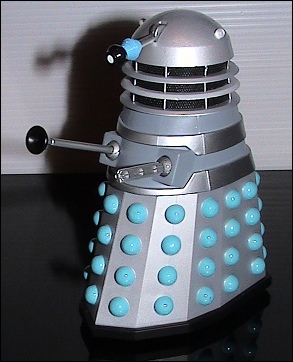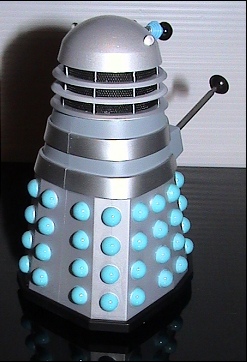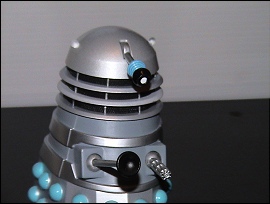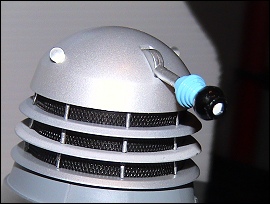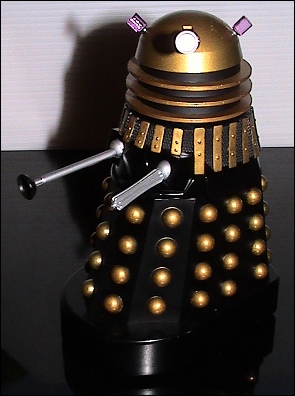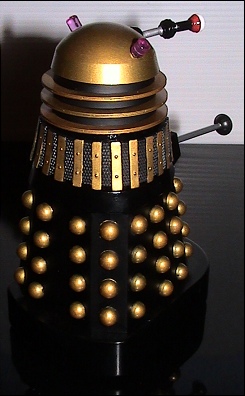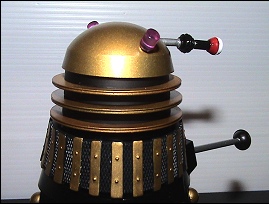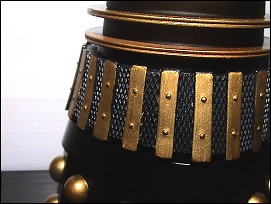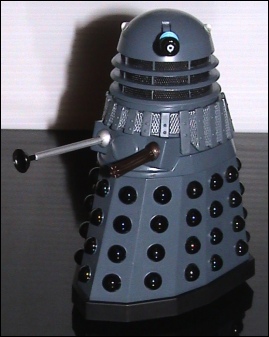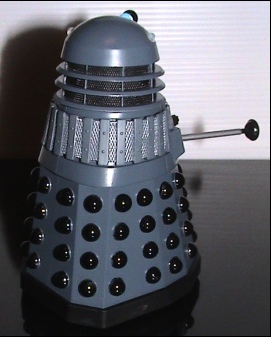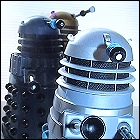 In 2008, the news became official that Doctor Who collectors had scarcely hoped for: Character Options, makers of the roughly-5″ scale action figures from the new series of Doctor Who, would at last be stepping in the past and creating figures of characters from the classic series. While fans may have thought it was a long time coming, Character’s long-delayed entry into classic series merchandise was fraught with difficulties to which most of the fans weren’t even privy: another company, Product Enterprises, had the classic series merchandise license locked down, forcing Character to sublicense through them with the BBC’s permission. And even with the license secured, it wouldn’t be an easy road, with many a participant in the original series no longer living – getting likenesses approved or denied would prove to be a headache, as some actors’ estates simply didn’t consider this merchandise a priority. But one of the earliest assurances, thanks to the BBC’s part-ownership of the designs, was that there would be a boxed set of various styles of classic series Daleks.
In 2008, the news became official that Doctor Who collectors had scarcely hoped for: Character Options, makers of the roughly-5″ scale action figures from the new series of Doctor Who, would at last be stepping in the past and creating figures of characters from the classic series. While fans may have thought it was a long time coming, Character’s long-delayed entry into classic series merchandise was fraught with difficulties to which most of the fans weren’t even privy: another company, Product Enterprises, had the classic series merchandise license locked down, forcing Character to sublicense through them with the BBC’s permission. And even with the license secured, it wouldn’t be an easy road, with many a participant in the original series no longer living – getting likenesses approved or denied would prove to be a headache, as some actors’ estates simply didn’t consider this merchandise a priority. But one of the earliest assurances, thanks to the BBC’s part-ownership of the designs, was that there would be a boxed set of various styles of classic series Daleks.
Comparitively smaller to the new series’ tank-like, up-armored Daleks, the trio of classic Daleks are still a marvel of attention to detail. The 1963 model Dalek, from the creatures’ first appearance in The Daleks, is accurately represented as the shortest version, with no vertical “slats” and light-bulb shaped “ears” (because that’s what they were!). In many ways, to this day, this is the “cleanest” and most uncluttered Dalek design there is. The color palette is carefully replicated from existing behind-the-scenes photos of the original props: this Dalek is silver, with blue half-spheres lining its lower half.
It’s worth pointing out that Character’s use of an appropriate special midsection for the ’63 model is a huge step up for Dalek toys. Dapol turned out Dalek figures aplenty in the silver-and-blue livery, but they all had the “vertical slats” that had been built into their standard Dalek body mold from day one; the slats didn’t appear until the Daleks’ third story, The Chase, in which they were added to the design to evoke the image of solar power panels (a point that seems to have been lost on the modern Daleks).
The next version is the relatively large Supreme Dalek, from the 1973 Jon Pertwee epic Planet Of The Daleks. Featured only briefly in the latter half of that six-part story, this Dalek is clearly retrofitted from the Dalek casings manufactured for the two 1960s Peter Cushing Doctor Who films; its raised, rounded-off, almost car-like base makes it the tallest of the set, and its purple “jam jar” style “ears” are unique to this Dalek. Also unique to this Dalek’s singular appearance is its eyestalk, which faithfully replicates what the on-screen prop used as its eye: a large flashlight!
The Supreme Dalek demonstrates the strength (and, in this case, weakness) of Character’s process for generating the back Dalek molds: the basic sculpts are made of interchangeable, modular parts, allowing for variations in the base, the midsection, the head, and so on. The Supreme Dalek sports the same midsection – with slats – as the other Dalek in the set, the 1975 Genesis Of The Daleks model, but it also has the central “oval” which wasn’t introduced to any of the Daleks until Genesis – hence it actually wouldn’t have been seen in the 1973 story. This is really the only noticeable goof in the entire set, and it’s such a minor one that, even though I noticed it, it falls below the radar of things that anyone should really care about. Especially not when looking at the staggering amount of detail that this sculpt gets right – the bolts holding the “slats” on are plainly visible, and the slats aren’t perfectly aligned or perfectly flat. It’s a remarkably accurate representation of the Dalek props and the heavy use that they were suffering through at this point in the show’s history. The imperfections make them more “real” to me than a more “perfect” version would have.
The all-grey Daleks as seen in Genesis Of The Daleks may well be the most iconic version of the creatures included here, because these molds were either used, or copied very closely, for the remainder of the original series’ run, through 1988’s Remembrance Of The Daleks. The eyestalk sports the accurate “eye-with-eyeball” look that the Daleks had for the rest of the series, and the “ears” are the car-blinker style that had been seen since the Daleks returned in 1972’s Day Of The Daleks. They’re just great figures – I wouldn’t mind “army building” with more of the Genesis Daleks.
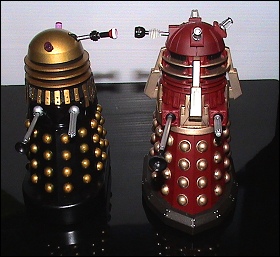 So is there a catch amid all this wonderfulness? There is, and sadly it’s a fairly large one. Perhaps due to the modular nature of the basic sculpt, the joints used for the Daleks’ gun and arm are different from those used in the new series Dalek figures, and that’s a problem. Rather than a free-and-easy ball joint, the appendages have a very limited range of movement, and issues with the paint used limits the movement even more. Numerous fixes have been suggested, ranging from dipping one’s Daleks in boiling water (!) to carefully applying just the right amount of pressure to the “ball” that the appendages portrude from and wiggling the appendage (a process that’s simply impossible to describe without it sounding rude).
So is there a catch amid all this wonderfulness? There is, and sadly it’s a fairly large one. Perhaps due to the modular nature of the basic sculpt, the joints used for the Daleks’ gun and arm are different from those used in the new series Dalek figures, and that’s a problem. Rather than a free-and-easy ball joint, the appendages have a very limited range of movement, and issues with the paint used limits the movement even more. Numerous fixes have been suggested, ranging from dipping one’s Daleks in boiling water (!) to carefully applying just the right amount of pressure to the “ball” that the appendages portrude from and wiggling the appendage (a process that’s simply impossible to describe without it sounding rude).
I could go into a wide range of issues here, ranging from my opinion that the consumer really shouldn’t have to do that much major repair on a toy straight out of the box, to the great likelihood that the stiff arms and guns will be broken off in the course of trying to get them to move for normal play before such repairs can be effected, but it all boils down (ahem) to the same thing – as great as these Daleks are in the detail department, their poseability is seriously hindered. Even after trying some of these fixes, I wound up leaving well enough alone on my Daleks so I wouldn’t break anything. It’s a shrug of the shoulders to a collector like myself, who will simply put these on a shelf somewhere anyway, but to a kid looking to add some “senior citizens” to his Dalek army, that’s just not good enough. I have several of the new series Daleks and haven’t lost a single arm or gun on any of them. Why the change was made, I have no idea, but they should’ve just stuck with what worked.
That issue aside – and it is a fairly major issue – the classic Dalek Collector’s Set (with “#1” tantalizingly displayed on the box, hinting at more to come) is a dream come true for longtime fans of the series, or younger fans just discovering the pre-Eccleston era’s wealth of adventures and characters. I suspect Character Options will bring us plenty of Daleks down the road for the same reason Dapol churned out so many – no pesky (and expensive) likeness approvals – but with its modular “kit” approach to building Daleks, Character’s doing it right, getting details right that the fans are looking out for. That unique way of doing things seems like it would make it easy to turn out custom-made Daleks for any story that they featured in, from the ’63-style Dalek with a big honkin’ “dish” on its back from Dalek Invasion Of Earth, to the silver-and-black corrugated-metal skirts of the Daleks in 1974’s Death To The Daleks, to the much more modernized Imperial Daleks (and – dare we hope? – the grimy Special Weapons Dalek) of Remembrance. Character’s not just content to create one mold and repaint it endlessly (or cast it in glittery green and purple, for that matter). That alone earns a lot of respect in my book.
